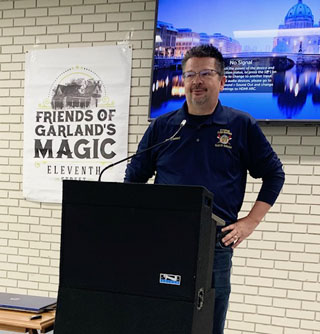Latino leaders Alex Martinez and Gus Hinojosa shared interesting and inspirational information at the recent Magic 11th Street annual meeting. Both are with Hispanic Organization for Genealogy and Research (HOGAR).
The men said that one of their organization’s goals is to “disassociate” some of the mythology pertaining to The Alamo. Survivor Susannah Dickinson was interviewed numerous times because she spoke English. However, there were also numerous female Tejanos present, and no one had showcased their recollections.
More than a century later a number of those descendants were asked to write essays to tell remembrances of their multi-great grandparents who were part of the Alamo siege. Those accounts differ from the widely circulated official recollections.
As a result of this and for many other reasons, a movement is now under way to create a permanent Texas Mexican American Museum. It would pull stories of this nature together and represent what has been identified as nine distinctive cultural regions in Texas where Latinos live. Architecture programs in Texas are being involved to draft a design for the museum. Visit http://www.TMAMT.org to learn how to support the museum.
Pop-up exhibits are being used now to ready the public for what is to come. One was the Texas Tamalada exhibit at Dallas City Hall in December. It explored the family tradition of creating enchiladas. Hinojosa said the tradition of tamales is more than 7,000 years old and added that they originated because they “kept well” for warriors going off to war.
they originated because they “kept well” for warriors going off to war.
He said the goal is to create exhibits that can travel and can be displayed for further exposure. Hinojosa explained that it is a long history “that needs to be told by us and not by others.”
“Some regions may have museums, but no single museum represents the whole state. The organizers will ask the regions to write their own history and send their artifacts, because “all regions are vastly different,” said Hinojosa.
One of the TMAMT’s pop-up projects honored the first five families that arrived in Dallas’ Barrio El Poso, beginning in 1915. The neighborhood was in the area where Interstates 30, 75, and 45 come together; the neighborhood was devastated as the highways were built. Martinez called it “social injustice at its best.”
Garland’s first Latinos, the Valles, arrived in 1928.
Both men talked about the value of DNA testing, which in Martinez’s case showed that he was more than 1/4 Native American. He also had a Polish third great-grandmother. His ancestors were living on Spanish land and the border between Texas and Mexico was superimposed on them by the U.S. government.
“We never crossed the border; the border crossed us,” he said. “We want to hold that pen when we tell our story,” Martinez said about going forward.
He promoted the upcoming 44th Annual Texas Hispanic Genealogical and Historical Conference in Dallas scheduled for Oct. 4-5 at the Renaissance Dallas North Hotel. Garlandites Sylvia Valle and Kay Moore will be presenters.
Mayor Scott LeMay and District 2 Council Member Deborah Morris were in attendance at the nonprofit’s annual meeting. LeMay lauded the Magic 11th Street organization.
“It started with the street, but it has become more about the people, people that made these places. If you can tune out the noise (proclaiming differentness) for half a second, we’re all the same,” he said.
Morris commended the Friends organization for “sharing the stories that bring us together on a very different level”.


